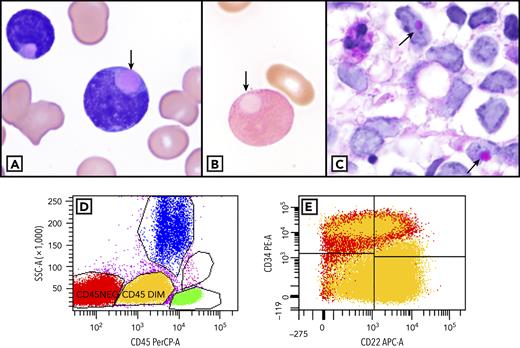A 56-year-old man with 4 months of dyspnea on exertion was found to be pancytopenic (leukocytes, 1600/μL; hemoglobin, 7.0 g/dL; platelets, 127 000/μL). Bone marrow aspirate showed 80% blasts, with ∼25% demonstrating eosinophilic cytoplasmic inclusions (pseudo-Chediak-Higashi-like; panel A, 100× objective, total magnification ×1000) that were myeloperoxidase negative (panel B, 100× objective, total magnification ×1000) and periodic acid-Schiff (PAS) positive (panel C, core biopsy, 100× objective, total magnification ×1000). Flow cytometry (panels D-E) showed 2 blast populations: CD45dimCD34− and CD45-CD34+; both cTdT+ with partial CD20, CD19, CD22, cCD79a, and CD33 (aberrant) and negative for all other myeloid or T-cell markers. Blasts were PAX5+, confirming B-acute lymphoblastic leukemia without cerebrospinal fluid involvement. Karyotype was normal. Fluorescence in situ hybridization studies were negative for BCR::ABL1 and CRLF2 and KMT2A rearrangements, but identified 3 copies of CRLF2 and KMT2A, implying hyperdiploidy.
Pseudo-Chediak-Higashi granules are described in myeloid blasts, especially in acute myeloid leukemia with t(8;21); the presence of similar granules/inclusions in lymphoblasts is exceedingly rare. Ultrastructurally, they consist of irregular membrane-bound structures of varying electron densities and can stain negatively or faintly, or positively with PAS. Although no common biology has been identified, it is a morphological peculiarity that may allow early relapse detection and reminds us that their presence should not skew the pathologist toward favoring a myeloid lineage.
For additional images, visit the ASH Image Bank, a reference and teaching tool that is continually updated with new atlas and case study images. For more information, visit http://imagebank.hematology.org.


